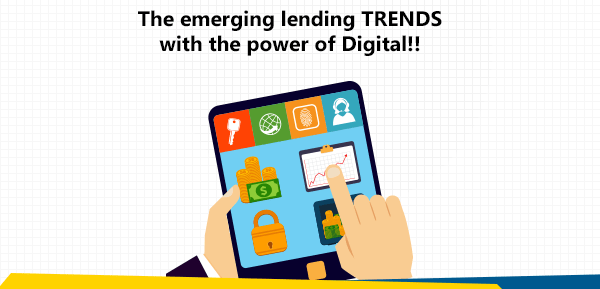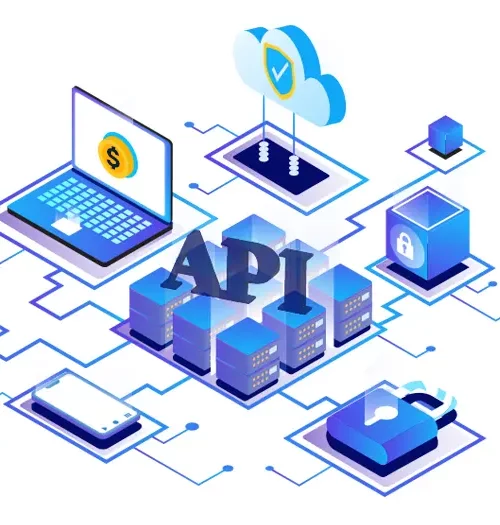


The world around us is continuously evolving and the financial sector is not an exception. With the start of 2019, there are some important trends to be watched in lending trends. The digitization is one of the major trends that has resulted in a drastic change in the lending industry. This has encouraged some financial organizations to try new marketing strategies and offer new products to the customers.
Now that banking and financial sectors are moving digital, consumers are receiving better financial products and services. Customer experience and technological advancements are two major factors that drive the change constantly.
Read further to know more about the lending trends and how it would progress in 2019…
Latest Advancements & Trends

With the latest advancements, the loan processing system has changed drastically and still expected to evolve. The invention of cloud-based payment platforms has helped financial organizations to get better a way lot. It helps with faster and continuous service, up-to-date functions with newer functions, and much more. This has also paved the way to options such as initiation of loans from anywhere anytime through an internet connection.
- Short-term lending to gain pace
- Paperless system is accelerating
- Enhance the digital experience for consumers
Short-Term Lending to Gain Pace
You may wonder what “short-term” lending refers to? Short-term lending is already existing in western countries and now started becoming popular in India as well. Pay-day loans or unsecured loans is usually referred to as short-term lending. Lending startups have already started offering these services and mainstream banks are slowly moving towards short-term lending products.
Paperless System is Accelerating
The advancement in FINTECH (Financial Technology) has resulted in a paperless system. With the new Aadhaar verdict, the eKYC procedure has taken a new look. There are several changes in eKYC verification, and few updates are yet to be implemented. As a result of new-age lending systems, the eKYC can be verified online.
Enhance the Digital Experience for Consumers
Speaking of technology, digitization and automation of lending services have changed the way the people use these financial services. In fact, holding to manual processing will only accelerate the process backward. Going digital not only makes the process flow smoother, but also boosts the overall experience of the consumers.
With clearly defined user-interface, you can have an interactive system that helps your consumers to get the work done in a short period of time. The use of enhanced tools and digital offerings has made the process so simple, that people can easily apply for a loan without even stepping into a financial organization.
Initially, financial processes usually involved a lot of paper-works and mandate a huge amount of storage space. But then, the digital platforms have given a total face-lift. This has changed the lending process and even small-scale financial organizations are providing digital services.
This wouldn’t stop with this. With banks and financial organizations gone digital, India is moving forward to paperless and presence-less delivery of financial services. Further developments and innovations are expected to happen in the customer onboarding space.
You may also like:
Technological Advancements
The technology is progressing and the impact of these technologies in daily life is growing drastically. The year 2019 seems to be a promising year for culmination of some key advancements in lending trends – ranging from blockchain, artificial intelligence to API platform and quantum computing. Below are the biggest trends that would revolutionize the lending industry:
- Role of Blockchain in Lending
- AI-Driven Predictive Banking
- APIs Everywhere
- Big Data Will Change Everything
- Cloud Will Become Omnipresent
- Robotic Process Automation (RPA)
- Provide Richer User Experiences
- Move Towards Digital Presentment
- Automation and digitization will define the mortgage process
- Things will go more mobile
- Use Predictive Analytics
Role of Blockchain in Lending
Blockchain technology is expected to transform the lending industry in several ways – ranging from mortgage loans to syndicated loans. At present, lending transactions depend on third-party intermediaries and include manual processes that are time-consuming and costly.
The invention and rise of blockchain has resulted a boom in financial services. With fintech and blockchain technology, it’s hard to ignore the transformation that has happened in the lending industry. This, in turn, has resulted in loads of opportunities for people who are otherwise shut out of the lending marketplace.
Also, blockchain technology has inspired the invention of several financial services that could significantly change the way everyone thinks about the lending.
AI-Driven Predictive Banking
One of the most innovating and exhilarating trends in 2019 will be the transition towards AI-driven predictive banking. Last few years in the lending industry have made it clear that AI-based banking as a next massive evolution in all the integral sectors of the financial industry. Since banking is one of the most data-driven industry, the role and impact of AI is high and is crucial for surviving the next major data revolution.
One of the major and widespread utilities of using AI-based predictive banking is to enhance client engagement and retention. By using Artificial Intelligence to modify administrative tasks, the employees can concentrate more on building relationships with their customers.
Also, fraud detection can be done in a better way. The boom of this revolutionary technology has unfolded various channels for interactions and communications. This includes web site, mobile applications, and ATM – this has significantly resulted in the elimination of frauds.
APIs Everywhere
Use of Application Programming Interface (API) helps lending organizations to build, configure, and manage their financial offerings, breaking the age-old traditional banking methods.
The emergence of API-based banking has transformed Lending-as-a-Service (LaaS) for all the business organizations that mandate working capital from their bank. With the invention of APIs, lending operations for financial organizations have been transformed to a whole new level. This has enabled several new operational efficiencies within your internal operations. Also, this has dramatically increased your speed to market.
Today with mobile devices taking the prominent place in every individual’s life, new applications are emerging from a wide base. Banking applications have been a great boon as they help people to access their account, get assist from the bank even from a remote location. It serves as an interface between various software programs and facilitates their interaction between the user and the system. This has enabled banking and financial organizations to provide banking services to the customers at their door-step.
Big Data Will Change Everything
Big data is playing a crucial role in major industry sectors, and banking and financial organizations are no exception. For lenders and financial institutions, two factors play a prominent role that drives to success – accuracy and predictability.
Lenders use big data analytics to analyze when a borrower will repay his/her loan or when they are likely to be sent to a collector to repay the money. This shows the difference whether the business is running in profit or loss. With the help of data analytics, the lenders can get a precise output from the stored data.
Fortunately, the emergence of big data in the financial industry is allowing more entrepreneurs to get loans easily. At the same time, it enables banks to remain profitable. Now, wondering how big data is changing the things? Read further…
More than credit scores, financial organizations have access to more data about the user. Financial organizations usually sanction loans based on the customer’s present credit score. However, a credit score doesn’t tell you clearly about the business idea or its worth. Using more data points provide a clear picture of each prospective customer.
Big data helps in better risk assessment – the key responsibility of a lender is to assess and analyze the risk. When utilized properly, big data helps banks and financial organizations in effective decision making. But with limited information, these projections and decisions are often subjective and unreliable. On the other hand, with more data points, banks will be able to get a clearer picture or risk and reward for potential loans.
Thus, using big data would be of great help for lenders as they would enjoy better insights about the borrowers. At the end of the day, it’s all about better insights on the borrowers that helps in reducing or eliminating the risk.
Cloud Will Become Omnipresent
In the recent years, cloud technology has garnered a lot of interest from the financial and banking industries. The cloud has the potential to completely transform the ways financial organizations conduct their businesses.
As cloud technology is evolving and getting sophisticated more and more, its role in the financial industry is getting evolved. For instance, DBS Bank – one of the largest banks in South-East Asia, has moved a major part, say more than 50%, of its compute workload to the cloud platform.
Now that banks and financial organizations are moving to cloud-based solutions, banks are collaborating with their partners over cloud-based software solution platforms. Software modules could be easily located on the servers of the various service providers and can be utilized for developing a decentralized, cloud-based platform.
Financial institutions are continuously utilizing omnichannel strategies in order to reduce or manage the data explosion. Along with the existing channels, they are likely to make use of the Internet of Things (IoT).
The potential future of omnipresent banking has led to a state of true consistency. This has also led to zero switching costs, zero waiting time, and seamless experience. At the same time, we should be mindful about the security issues and privacy concerns, implementation issues, and much more. But still, there is a huge potential to change the game of lending and make banking and financial services absolutely seamless.
You may also like:
The use of software robots to automate the backend tasks such as documentation, filing and routing, email reminders, and much more is referred to as robotic process automation. When RPA is combined with other automation tools, it would allow for workflows to be built from the beginning to the end.
Lending customers are expecting more and more from the financial organizations and banking industries. They look for instant responses for their queries and expect online portals. To make this all possible, RPA would be the right choice.
RPA enhances the overall operational efficiencies throughout the business via a combination of optical character recognition (OCR), automatic object recognition, and direct application integration. Below are the applications of RPA in lending and mortgage industries:
- Data entry and transfer
- Data compilation
- Workflow management
- Verification and reconciliation
- Routine transaction processing
Leveraging RPA in the lending industry would result in speed, accuracy, and agility to the financial organization. This results in the creation of significant business opportunities that drive great values.
Provide Richer User Experiences
Technological advancements have proven to bring in new and better opportunities than ever for the lenders, which would eventually help them to stay on the top. This would also help lenders to position themselves better in the upcoming years and offer better services to their customers.
Capturing the attention of your customers through rich user experience helps you to gain a strong customer base. Providing room for more services through digital platforms will be an add-on to the lenders.
Rich user experience to your customers can be provided through:
- Expanded payment options
- Mobile-first payment platforms
Providing these two options to your customers helps them to access their accounts as per their convenience – how they want to and from wherever they want. Having a mobile-first payment platform is highly important and reduces the friction that occurs during the payment process. This, in turn, provides better payment options and more user-engagement as well, which eventually results in on-time payments.
Move Towards Digital Presentment
With more and more advancements, lenders as well as borrowers, are moving towards digital presentment. This would help financial organizations to boost their payment processes and to implement new features to the existing system.
With financial organizations moving to digital, lenders can cut-off the paper-works and accelerate the overall payment process. It also makes room for quicker, easier, and safer payment options. Also, opting for digital helps lenders to introduce more features to the lending system including the payment reminder options, payment confirmation through instant notifications, integration of mobile wallet, and much more.
Also, moving lending services to digital payment platforms brings in additional benefits such as user-friendly service, trusted mode for a transaction, and secure payment options for lenders as well as borrowers.
Automation and Digitization Will Define the Mortgage Process
Automation and digitization are set to transform the mortgage industry by addressing a broad range of issues including better customer experience, processing, and overall security issues.
This has helped mortgage lenders to overcome all the issues that usually occur in manual processing. With the industry evolving continuously, retail customers are looking for affordable bank products that do not necessitate the help of banking consultants.
The modern-day mortgage processing optimizes non-customer-facing processes through latest technologies. This results in the delivery of high-quality services and better customer satisfaction. Also, this allows banks and financial institutions to more effectively target their customers with the right offers at the right time.
Therefore, a financial organization that embraces digitization will have better mortgage processing. Automation of lending would help lenders to operate with better capabilities and be flexible to their customers as well. The advancements in the financial industry has resulted in great success, but then, the industry is still expected to evolve with better capabilities.
Role of Mobile Apps
Mobile applications are becoming efficient and they are user-friendly as well. The lending industry is no exception to this. With banking and financial services going purely digital, all the tasks including balance check, financial transactions, paying bills, and all other bank-related tasks can be carried out at a faster pace.
Mobile banking applications are completely safe and secured and include reliable security features. All mobile applications include access PIN or passwords that restrict user access. These apps are secured by several security layers and firewalls.
Thus, increased availability of services through mobile apps boosts the overall user engagement to the bank. This ultimately results in higher revenue.
Use of Predictive Analytics
Predictive Analytics help lenders to modify their lending policies and practices related to market changes.
Use of predictive analytics would help lenders to modify their policies and practices based on the market changes. Now that people and business organizations are completely data-driven, financial organizations and lenders would get the ability to integrate all complex functions together. This includes payment options, platforms, and gateways.
Predictive analytics would help lenders and financial organizations to better understand profit and loss. Additionally, lenders can leverage the stored data to determine the behavior, key characteristics, and gain insights about their customers. It also helps to eliminate bottlenecks in the lending process and provides necessary information regarding payment frauds.
Therefore, implementing predictive analytics in the lending process would help financial organizations in detecting frauds, to analyze profit and loss, and offer better services.
You may also like: How Mobility is transforming the Lending Sector
Conclusion
As a result of the digitization and automation process, several financial organizations have started receiving heavy investment over a long period of time. In fact, organizations now have their own platforms and applications for offering their services. While these online applications and platforms are developed with high-end technologies, some of the applications have failed to address specific lending requirements.
But then, some of the financial organizations are providing some exceptional lending services for various organizations. Even traditional lenders have started moving towards digital platforms. This has resulted in an effective offering of financial products and services. But this does not stop with this. The industry is expected to evolve in upcoming years and there are a lot more to come that would create a great change in the lending trends in the upcoming years.
Related Post

18 Fintechs in Chennai You Should Know About
Technology has found a home in every industry. In other

OCEN Technology: The Revolution in MSME Lending
Amid our dynamic financial ecosystem, the Open Credit Enablement Network

Why Should Your Lending Business Get Api-Fied: A Comprehensive Guide To Understanding Lending APIs
47,40,00,00,00,000! Counting the zeros? Let’s simplify it.INR 47.4 Lakh crore. That
- Email: salesteam@cloudbankin.com
- Sales Enquiries: +91 9080996606
- HR Enquiries: +91 9080996576